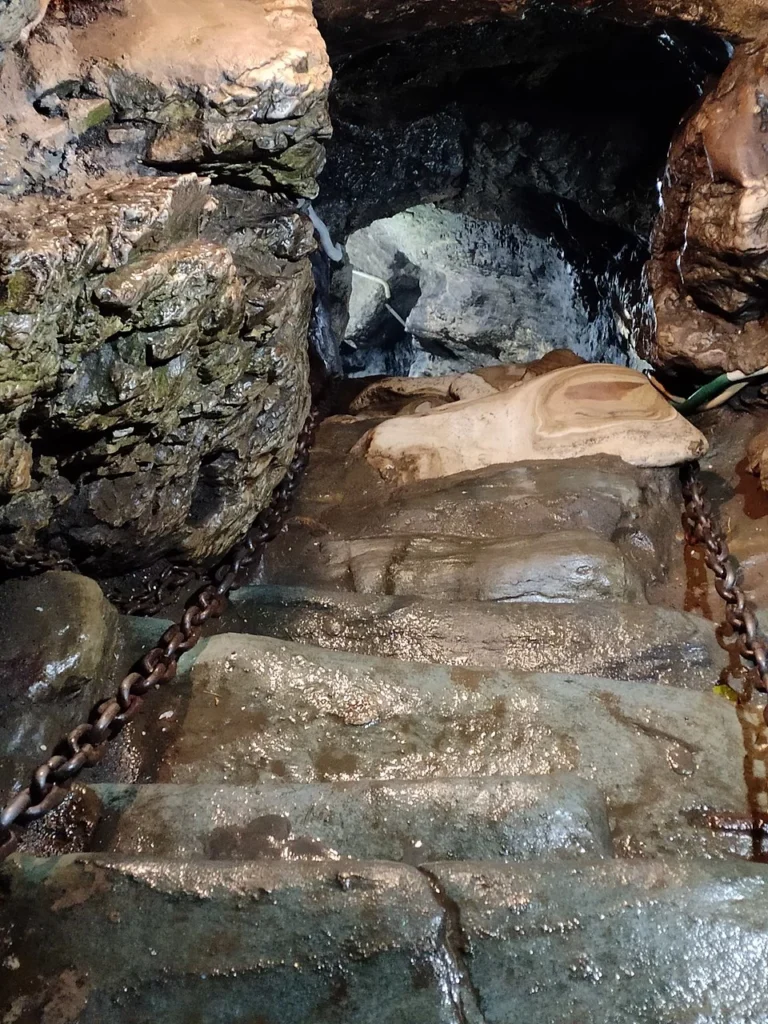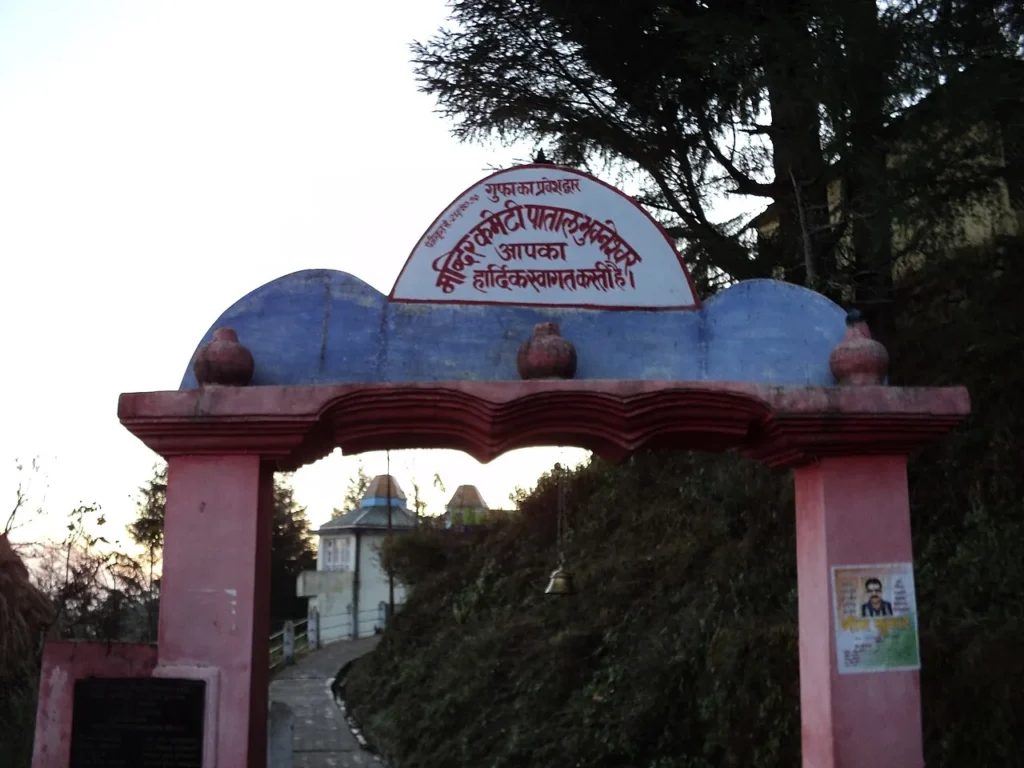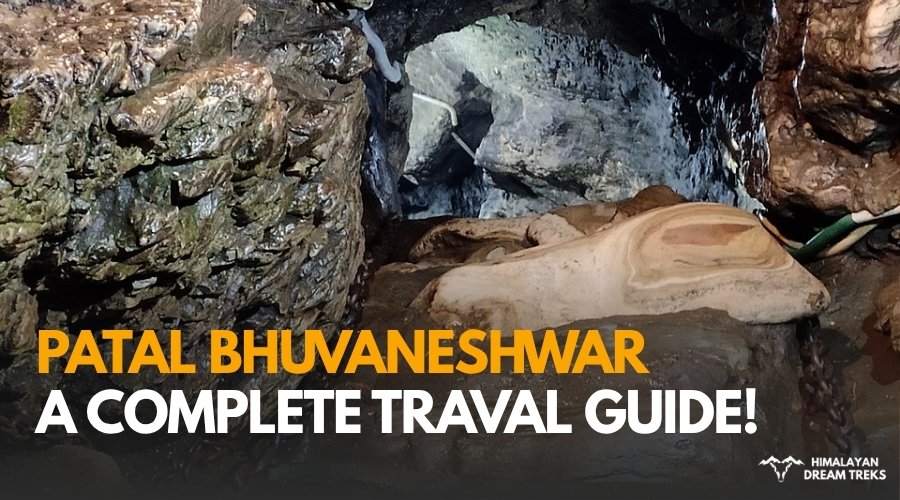Patal Bhuvaneshwar, a sacred and spiritual cave in the Uttarakhand state of northern India, is a major site of pilgrimage in the region. Situated among beautiful hills, dense forest, and magnificent views, the cave is where nature and religion blend into one another in complete harmony.
History and significance of the cave are well-established in Hindu spirituality and therefore it is a holy site where one would love to offer respect to the gods and goddesses who are believed to be residing within.
For every traveler, Patal Bhuvaneshwar is a pilgrim center where they get physical as well as spiritual rejuvenation. In this comprehensive blog post, we are going to explore the history, spiritual, religious importance and functional facts for travelers who wish to visit this enchanting cave temple.
Table of Contents
Where Is Patal Bhuvaneshwar Located?
Patal Bhuvaneshwar is situated in the district of Pithoragarh in Uttarakhand, India. It is approximately 91 kilometers from Pithoragarh town and only a few kilometers from a small town named Gangolihat. The cave is at an altitude of around 1,350 meters (4,430 feet) above sea level within the Kumaon Himalayan range.

Located amidst dense deodar and oak forests, this ancient cave temple provides a breathtaking view of snow-capped mountains and valleys. Though far from civilization, the place is well connected by road, and one can easily come here by car or bus from nearby towns.
Historical and Religious Significance of Patal Bhuvaneshwar Temple
Patal Bhuvaneshwar is said to be a natural limestone cave, whose formation is thousands of years old. It is located far inside the hills of the Uttarakhand state, close to the town of Gangolihat in Pithoragarh district. It is said to be the entrance to the underworld, or the Patal Lok, where several gods, goddesses, and supernatural beings reside.
The inner cave temple is the Lord Shiva temple and is said to be one of India’s most sacred shrines. Indeed, this cave itself is said to be the abode of multiple gods and goddesses, each room and rocky structure representing another god.
Spiritual Connection of Patal Bhuvaneshwar
As per ancient Hindu stories, the cave was found by King Rituparna in the Treta Yuga, an old time as per Hindu texts. King Rituparna, as per legends, while exploring hills, found the cave and received a divine power there. Meanwhile, Lord Shiva is also said to have appeared before the king and showered divine wisdom upon him.

There is another important fact about the cave being that it is connected with the Pandavas, the five historical brothers of the Mahabharata. The Pandavas came to Patal Bhuvaneshwar while they were in exile and performed several rituals to appease the gods. Some even claim that the cave was used as a meditation center by the Pandavas when they were staying in the jungle.
Cave and Its Natural Beauty
Patal Bhuvaneshwar is a naturally occurring limestone cave that has evolved over thousands of years. The cave is around 90 feet deep, and the tourists have to go down narrow stone steps to reach the cave. The cave entrance is narrow, but inside, tourists find a series of narrow, ring-shaped tunnels that guide them through several chambers. The rooms are adorned with peculiar rock formations that have been naturally carved by water droplets over centuries.
Within the cave, several stalactites and stalagmites depict different gods and spiritual beings. There are several rooms within the cave with their significance and names as well, one for each god and goddess. The most characteristic features within the cave are:
- Lord Shiva: The central deity of the cave, Lord Shiva is said to be present here in the form of a Shivling. Pilgrims come to the cave to worship and seek blessings from the Lord.
- Lord Vishnu: The cave also has a statue of Lord Vishnu, symbolising the saviour of the world.
- Sheshnag: Sheshnag is a divine snake in Hindu history who is said to be carrying the earth. His section of the cave remains empty for him, where his aura can be felt by the tourists.
- Kailash Parvat: One of the rock formations within the cave looks like Mount Kailash, which is said to be the residence of Lord Shiva as per Hindu beliefs.
Apart from these gods, some other gods, goddesses, and spiritual characters have also been shown, including Kapil Muni, King Janak, etc. These rocks give the cave a divine look, and a person feels spiritual when they visit the cave.
How to Reach Patal Bhuvaneshwar
If you’re travelling to Patal Bhuvaneshwar, then here are some options for you to understand how to get to this holy place.
By Flight
The closest airport to Patal Bhuvaneshwar is Pantnagar Airport in Uttarakhand.
- Pantnagar to Patal Bhuvaneshwar: Around 250 kilometers
- Road Travel Time: Around 7–8 hours
- Pantnagar has a few flights, mostly from Delhi. Upon reaching Pantnagar, you can take a bus or taxi to Patal Bhuvaneshwar.
If you want more flight options, you may also utilise Indira Gandhi International Airport in New Delhi. A train or bus may then be used from Kathgodam to reach nearby cities like Haldwani or Kathgodam.
By Train
The nearest major railway station is Kathgodam Railway Station.
Kathgodam to Patal Bhuvaneshwar distance: About 180 kilometers
- Road travel time: About 6–7 hours
- Kathgodam is well linked with most of the big cities like Delhi, Lucknow, and Dehradun. You can take a taxi or local bus from the railway station to go to the temple complex.
It is also accessible to Tanakpur Railway Station, but it is farther and less linked than Kathgodam.
By Road
Patal Bhuvaneshwar is easily reachable by road. Drive yourself, taxi, or take a local bus.
- From Pithoragarh: 91 km (3 hours)
- From Gangolihat: 14 km (30 minutes)
- From Haldwani: About 180 km (6–7 hours)
Regular buses and shared taxis from Almora, Pithoragarh, and Berinag to Gangolihat are available. Patal Bhuvaneshwar is at a driving distance from Gangolihat.
Hike to the Cave Entrance
As soon as you reach the parking area near the cave, you will have to walk a bit downhill. The entrance to the cave is via very narrow stairs, and there are guides present nearby to help you.
Best Time to Travel
- The best time to travel is March to June and September to November.
- Avoid traveling during heavy rains (July–August), as roads may become slippery.
Tip: Regularly check road conditions and weather forecasts before undertaking a journey, especially when traveling during winter and monsoon seasons.
Patal Bhuvaneshwar is a peaceful area rich in history, mystery, and nature. With the right trip plan, visiting this sacred cave will be a pleasurable and trouble-free experience.
Pilgrimage Experience: What to Expect When You Go to Patal Bhuvaneshwar?

A visit to Patal Bhuvaneshwar is an experience that is greater than a tour of a cave. It’s a destination where you can find connections with age-old legends, ask for blessings, and feel the energies of nature and religion. Here are some things you can anticipate when you go to the cave:
Sacred Journey Down the Steps
The trek to Patal Bhuvaneshwar starts on a steep route over narrow stone steps. On the way, as you descend, you realise that the surroundings are getting cooler and you start feeling calm and peaceful. The route to the cave has thick green covers all over it, further giving calmness to the trek. Tourists tend to halt at various points on their way to get in touch with nature and to adopt the peaceful surroundings.
Inside the Cave
Once you are inside the cave, you will experience how the environment is different. The cave is dark and cold, with only lights from the lamps and candles that devotees have left behind. The stalactites and stalagmites inside the cave are lighted, providing a heavenly ambiance. As you proceed deeper into the cave, you will see various chambers, each belonging to a particular deity. Each of the deities is experienced through the natural environment, lending a mystical aura to the experience.
4-Day Trip Itinerary to Patal Bhuvaneshwar

Day 1: Arrival at Patal Bhuvaneshwar (via Almora or Chaukori)
Morning:
- Arriving at either the Pantnagar Airport or the Kathgodam Railway Station, drive to Patal Bhuvaneshwar from Almora (about 200 km, 6–7 hours) or Chaukori (about 90 km, 3 hours).
- Enjoy breathtaking views of Himalayan foothills and tiered valleys.
Afternoon:
- Check-in at a guest house or KMVN visitor rest house.
- Have a Kumaoni meal locally.
Evening:
- Leisure walk around the calm Gangolihat village
- Optional: See the Shakti Peeth, Haat Kalika Temple, supposedly built by Adi Shankaracharya nearby.
Overnight: Stay in Patal Bhuvaneshwar
Day 2: Exploring the Spiritual Patal Bhuvaneshwar Cave
Morning:
- Visit the Patal Bhuvaneshwar Cave Temple between 9:00 AM to 5:00 PM.
- Explore the cave, which is around 90 ft deep, with a local guide.
- Get amazed by natural limestone formations which resemble gods and goddesses: Shiva-Parvati, Sheshnag, Amarnath, among others.
- Experience spiritual ambiance and religious relevance.
Afternoon:
- Lunch at one of the nearby guest houses or dhabas.
- Take a rest and document your experience.
Evening:
- Shop at the nearby market for handloom woolens and herbal medicines.
- Spend an evening of stories and bonfire with locals; they share great stories about caves.
Overnight: At Patal Bhuvaneshwar
Day 3: Day Outing to Chaukori or Berinag
Option A: Chaukori (for nature enthusiasts)
Morning:
- Drive for about 2.5 hours to Chaukori.
- Tea gardens and huge Himalayas (Nanda Devi, Trishul peaks) as a view.
Afternoon:
- Lunch at a view-over cafe
- Either view Kapileshwar Mahadev Cave Temple or Nag Devta Temple.
Option B: Berinag (for pilgrims & peaceful seekers)
- A little outing to see the historic Nag Devta Temple from Berinag (15 km). Pristine pine forests, perfect for picnics or meditation.
Evening:
- Return to Patal Bhuvaneshwar, perhaps for local cultural programming or folk music, depending on availability.
Overnight: At Patal Bhuvaneshwar Overnight
Day 4: Departure
Morning:
- Light breakfast and farewell tea.
- In return, it takes approximately 6 to 7 hours from Kathgodam to your onward destination.
Optional: If returning through Almora, visit Jageshwar Dham on the way (adds a couple of hours but well worth the journey).
Tip: Bring regional sweets or herbal teas as gifts
Safety Tips for Visiting Patal Bhuvaneshwar
Visiting a forested, off-beat location like Patal Bhuvaneshwari might be calm and beautiful, but safety comes first. Use these easy safety precautions to keep yourself safe on your travels:
1. Travel During the Day
- Always try to get around by day. At night, the mountainous roads leading to Patal Bhuvaneshwari are not well-lit and narrow.
- On steep roads, avoid late-night or last-minute travel.
2. Stay Hydrated and Eat Well
- Bring water with you everywhere, especially on trekking.
- Eat appropriately to keep your energy level for treks or woodland walks.
- From streams, avoid drinking untreated water; always use bottled or filtered water.
3. Trekking Safety
- Trekking by yourself is not advised. Always walk in a group or under direction.
- Leave early so you get back before evening fall.
- Trekking calls for a first-aid pack, torch, refreshments, and raincoats.
- Stay on designated paths; avoid crossing fresh ones.
- In deep jungles be wary of leopards, snakes, or wild boars. Keep a balance—do not sneak stealthily and avoid making too much noise.
4. Respect the Weather
- Check the weather before you leave.
- Visit only in July and August, the monsoon season, when landslides are likely.
- Snow or frost can make paths slippery in winter (Dec–Feb; take shoes with a good grip).
5. Speak with Locals
- The locals know the area. Don’t hold back while asking for help or direction.
- They can recommend better routes or warn you about hazardous paths or animals.
- Be polite and respectful; most people converse in Hindi or Garhwali.
6. Mobile and Connectivity
- Most places have either weak or no mobile signal.
- Tell your friends or relatives about your travel schedule before you get here.
- Plan a call when you find yourself in a place with connectivity, such as Mussoorie or Thatyur.
7. Wildlife and Nature
- Never feed or harass birds or other wildlife.
- Don’t pick flowers, or plants, or disturb birds or insects.
- Play no loud music in woodland environments; it disturbs the local fauna.
8. Health and Hygiene
- Before lunch, wash your hands. Should soap and water not be readily accessible, use hand sanitizer.
- Tell your host well in advance if you are not feeling great.
- The closest large medical center, should one be rather sick, is either Dehradun or Mussoorie.
9. Fire Safety
- Never set campfires without the forest staff’s authorization.
- Forest fires can strike quickly during the dry season, March–June.
- Before you go, extinguish any cooking flames, cigarettes, or matchsticks.
10. Be a Responsible Visitor
- Honor nature and leave nothing behind.
- Either take it with you till you can discard it correctly or throw garbage in dustbins.
- Stay in homestays, eat locally, and buy handcrafted goods to support the neighborhood economy.
A journey to Patal Bhuvaneshwari could be a transforming event full of calm, landscape, and friendly village hospitality. Good packing and careful safety practices will help you to enjoy the mountains, birds, and forests free from thought.
Conclusion
Patal Bhuvaneshwar is a site of spiritual, environmental, and historical significance not merely a cave. For both pilgrims and visitors, the cave is a pilgrimage one would never forget because of its traditions and myths paired with its serene surroundings. Patal Bhuvaneshwar is a rare chance to experience the force of religion and nature harmonizing in perfect unison, whether one is visiting to find religious favors or just to enjoy its natural beauty.
Should you ever find yourself in Uttarakhand, you really must see Patal Bhuveneshwar. It will leave you with recollections of a holy and serene location bringing you nearer to India’s rich spiritual and cultural legacy.

Leave a Comment